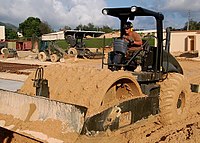
Photo from wikipedia
Abstract There is considerable interest in formulations with high active pharmaceutical ingredient (API) load, for reasons including lower patient tablet burden and therefore, potentially improved patient adherence. This remains a… Click to show full abstract
Abstract There is considerable interest in formulations with high active pharmaceutical ingredient (API) load, for reasons including lower patient tablet burden and therefore, potentially improved patient adherence. This remains a challenge not least because most APIs are poor flowing. Roller compaction (RC) improves the flow of powders and is especially useful for APIs which are heat or moisture sensitive. However, due to loss of reworkability, RC results in reduction of tablet radial tensile strength (TS). To achieve a balance between flow and TS an understanding of material property and RC process parameters is needed. Material properties such as Brittle Fracture Index (BFI) govern a powder's behaviour during compression. In this study; two APIs, ibuprofen (BFI = 0.12) and compound A (BFI = 0.44) were formulated at high load in an attempt to link BFI with the RC process. For both APIs, a roll force of 6 kN/cm was sufficient to attain granules of appropriate size and low fines. Ibuprofen formulation showed no conclusive correlation between roll force and flow, however, improved flow was seen in compound A formulation with increasing roll force. Both plastic-behaving ibuprofen and brittle compound A formulations demonstrated a reduction in tablet TS with increasing roll force. However, the ibuprofen formulation showed greater loss in reworkability.
Journal Title: Powder Technology
Year Published: 2018
Link to full text (if available)
Share on Social Media: Sign Up to like & get
recommendations!